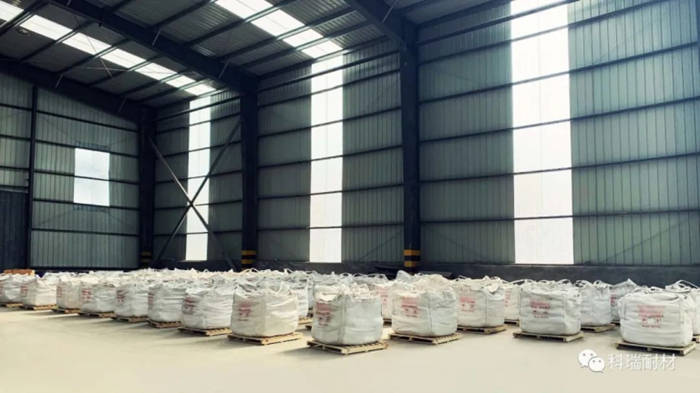Unshaped refractories are a mixture of refractory aggregates and powders, binding agents or other admixtures in a certain ratio. It can be used directly or with appropriate liquid blending. This is a new type of refractory material without firing, its refractoriness is not less than 1580 ℃.
There are various ways to classify unshaped refractory materials. Classification by chemical character: acidic, neutral, alkaline. Classification by delivery status: shaped products and bulk materials. From a practical point of view, they are generally classified by bonding agent type, refractory aggregate variety and construction production method.
Classification according to the type of binding agent
There are more types of binding agents, divided into inorganic binding agents and organic binding agents. In addition, inorganic binding agent is divided into cement, chemical, clay and other varieties, the application is very common.
| Binding agent | Unshaped refractory materials | |||
| Type | Examples of materials | Cement formation | Hardening conditions | |
| Inorganic | Cement | Silicate cement, aluminate cement | hydrated | hydraulic hardness |
| Chemical | Water glass, phosphoric acid, aluminum phosphate, aluminum sulfate, brine | Chemical, polymerization | Air hardness Hot hardness | |
| Clay | Soft clay | Coalescence, hydration | Air hardness Hot hardness | |
| Superfine powder | Activated silicon oxide, aluminum oxide | Coalescence, hydration | Air hardness Hot hardness | |
| Organic | Pulp waste liquor | tar pitch, phenolic resin | Chemical, adhesion | Air hardness |
| Composite | Soft clay with aluminate cement | Hydration, coalescence | Air hardness |
Classification by refractory aggregate species
Refractory aggregate is divided into two categories: heavy aggregate and light aggregate. According to the use of the aggregate prepared by the material weight is different, can be divided into heavy indefinite refractory materials and light indefinite refractory materials (bulk density less than 1800kg/m³); according to the chemical mineral composition of the material for classification, can characterize the basic composition and characteristics, more practical significance.
| Refractory materials | Material main minerals | |
| Kind | Examples of materials | Main minerals |
| High aluminous | Bauxite clinker, corundum | Mullite, corundum |
| Clay | Clay clinker | Mullite, square quartz |
| Semi-siliceous | Siliceous clay, wax stone | Square quartz, mullite |
| Siliceous | Silica | Squamous quartz, square quartz |
| Magnesian | Magnesium sand | Magnesite |
| Other | Silicon carbide | Silicon carbide |
| Silicon carbide | Aluminous chromium spinel | |
| Porous clinker | Mullite, square quartz | |
| Shale Ceramic Granules | Square quartz |
Classified by construction and production methods
1. Refractory castable material: Refractory castable material is also known as refractory concrete or refractory castable material, with good thixotropic properties, generally by pouring or pouring vibrating method of construction.
2.Refractory pounding material: the material formed by wind pick or manual pounding.
3.Refractory plastic: refractory plastic to refractory aggregate and powder with the appropriate binding agent, additive preparation, mud billet or irregular material mass. In a certain period of time can maintain a good plasticity, so it is called refractory plastic.
4.Refractory spray coating: Refractory spray coating system with a jet machine or pumping molding materials, such as for the furnace, also known as refractory spray patching material. When using flame jet machine to fill the furnace, it is called refractory fusion material. With wet material pumping or spraying material is also known as wet spray coating or pumping material.
5.Refractory coating material: refractory coating material system with plasterer and mortar pump molding or manual coating of the material.
6.Refractory projection material: refractory projection material with projection machine molding material.
7.Refractory pressed into the material: refractory pressed into the material with mud pumps and other pressure equipment molding materials.
8.Not burned bricks: not burned bricks with press molding products.
9.Prefabricated blocks: prefabricated blocks containing seat bricks and breathable bricks and other products formed with vibration or pounding.
10.Refractory mud or refractory mud: refractory mud or refractory mud system with tile knife or similar tools to build refractory bricks and prefabricated blocks of caulking materials.

